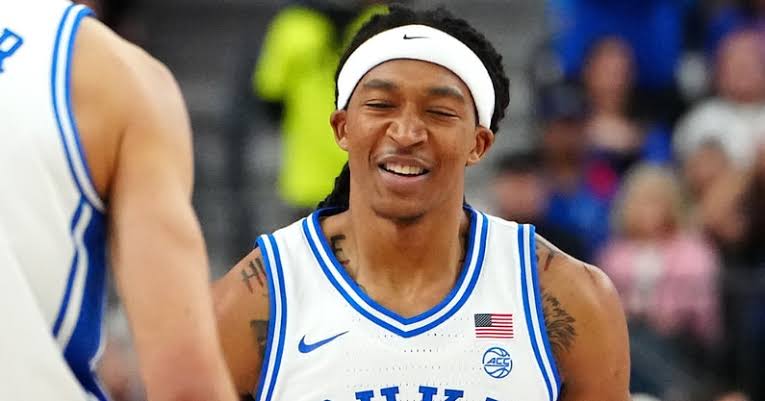In a season marked by both triumphs and challenges, the Duke Blue Devils men’s basketball team faces a significant hurdle with the recent injury to junior forward Maliq Brown. Brown, a pivotal defensive asset, suffered a dislocated left shoulder during the first half of Duke’s commanding 80-62 victory over Virginia on February 17, 2025. This injury not only sidelines Brown for an indeterminate period but also compels the team to reassess and adapt its strategies moving forward.
The Incident and Immediate Aftermath
The injury occurred during a high-stakes matchup at John Paul Jones Arena in Charlottesville, where the Blue Devils showcased their prowess against the Cavaliers. Midway through the first half, Brown collided with an opposing player, resulting in a dislocated left shoulder. He was escorted off the court and did not return for the remainder of the game. Post-game, head coach Jon Scheyer confirmed the severity of the injury, stating that Brown would “miss some time” and would be absent from the upcoming game against Illinois at Madison Square Garden. Scheyer emphasized that the exact timeline for Brown’s return would depend on the results of ongoing imaging and his subsequent recovery process.
Maliq Brown’s Role and Impact
In his inaugural season with Duke after transferring from Syracuse, Brown has been instrumental in fortifying the team’s defense. Standing at 6 feet 9 inches and weighing 222 pounds, his physical presence and defensive acumen have been vital in anchoring the Blue Devils’ defensive schemes. Brown’s contributions have propelled Duke to the sixth-best scoring defense in Division I, a testament to his impact on the court. His season averages include 2.5 points, 4.1 rebounds, 1.6 assists, and 1.4 steals per game, with a remarkable 76.9 percent shooting accuracy on two-point attempts.
Beyond statistics, Brown’s leadership and experience have been invaluable, especially to the younger cohort of players. His ability to read the game, make pivotal defensive stops, and mentor teammates has solidified his role as a cornerstone of the team’s dynamics.
Historical Context of Injuries
This isn’t the first time Brown has faced health setbacks this season. On January 11, during a home game against Notre Dame, he sustained a right knee injury that sidelined him for several weeks. The team demonstrated resilience during his absence, with other players stepping up to fill the void. However, the recurrence of injuries to a key player like Brown raises concerns about the team’s depth and the physical toll of a grueling season.
Strategic Adjustments in Brown’s Absence
The coaching staff now faces the challenge of recalibrating their strategies to compensate for Brown’s absence. Several players are poised to see increased roles and responsibilities:
-
Cooper Flagg: The freshman guard/forward, standing at 6 feet 9 inches, has already made significant contributions this season. Known for his versatility, Flagg is expected to take on more defensive duties, potentially filling the gap left by Brown. His ability to guard multiple positions and contribute offensively makes him a valuable asset during this period.
-
Khaman Maluach: At 7 feet 1 inch, the freshman center offers a substantial presence in the paint. While still developing his collegiate game, Maluach’s shot-blocking ability and rebounding skills will be crucial in maintaining the team’s defensive intensity.
-
Mason Gillis: The graduate forward brings experience and a physical style of play. Gillis’s tenacity on defense and proficiency in securing rebounds will be essential in offsetting the loss of Brown’s contributions.
-
Kon Knueppel: Another freshman guard/forward, Knueppel has shown promise with his defensive capabilities and scoring touch. Increased playing time could accelerate his development and provide the team with additional offensive options.
Head coach Jon Scheyer has a history of adapting to challenges, and this situation is no exception. In a recent statement, Scheyer expressed confidence in his team’s depth, stating, “We have a group of guys who are ready to step up. It’s an opportunity for others to showcase their abilities and for us to grow as a unit.”
Upcoming Challenges
The Blue Devils’ schedule doesn’t afford much respite. Their next game is a high-profile matchup against Illinois at Madison Square Garden. Illinois, known for its aggressive play and strong frontcourt, will test Duke’s adjusted lineup. The absence of Brown adds an extra layer of complexity to the game plan, particularly in defending the paint and controlling rebounds.
Following the Illinois game, Duke faces a series of conference matchups that are critical for maintaining their standing. Each game will require strategic ingenuity and collective effort to navigate successfully without one of their defensive linchpins.
Long-Term Implications
Brown’s injury not only impacts the current season but also has potential long-term ramifications. Repeated injuries can affect a player’s career trajectory and the team’s recruitment and development strategies. The coaching staff will need to monitor Brown’s rehabilitation closely, ensuring a balance between a timely return and long-term health considerations.
Moreover, this situation underscores the importance of depth in the roster. Developing younger players and ensuring they are prepared to step into more prominent roles becomes paramount. The experience gained by players like Flagg, Maluach, and Knueppel during this period could prove invaluable in future high-stakes games.
Fan and Community Support
The Duke community has rallied in support of Brown, with an outpouring of well-wishes on social media and during games. This collective support not only boosts player morale but also reinforces the tight-knit nature of the Duke basketball family.
Recovery and Rehabilitation Process
Maliq Brown’s recovery will be a crucial factor in determining when he can return to the court. A dislocated shoulder typically requires several weeks of rest and rehabilitation, depending on the severity of the injury. In some cases, players can return in as little as three to four weeks, but for more severe dislocations, the recovery timeline can extend to multiple months. Given Brown’s previous injury history this season, Duke’s medical staff will likely take a cautious approach to ensure that he does not risk re-injury upon his return.
Rehabilitation Stages:
- Initial Rest and Immobilization – Brown will likely have his shoulder immobilized in a sling for the first couple of weeks to allow the joint to heal properly. Pain management and reducing inflammation will be the focus during this period.
- Physical Therapy and Strengthening – Once the pain and swelling subside, Brown will begin a structured rehabilitation program designed to restore range of motion and build strength in the shoulder. A focus will be placed on stabilizing the shoulder muscles to prevent future dislocations.
- Basketball-Specific Drills – As he progresses in his recovery, Brown will gradually incorporate basketball-related movements, such as shooting, passing, and defensive positioning, to ensure he regains full functionality before returning to full-contact play.
- Re-Evaluation and Clearance – Before stepping back onto the court, Brown will undergo medical evaluations to determine if he is fit to resume competitive action. The medical staff, in collaboration with the coaching team, will make the final decision on when he can rejoin the rotation.
The Psychological Toll of Injury
While physical rehabilitation is critical, the mental aspect of recovering from an injury cannot be overlooked. Athletes often experience frustration, anxiety, and even fear of re-injury upon returning to play. For Brown, missing significant games during an important stretch of the season can be disheartening. However, his previous experience with injuries may equip him with the resilience needed to navigate this challenge.
Duke’s coaching staff and sports psychologists will likely play a crucial role in helping Brown maintain confidence in his body. They will ensure he stays engaged with the team through film study, meetings, and light on-court activities when appropriate.
The Bigger Picture for Duke Basketball
Brown’s absence highlights a larger issue that Duke will need to address—depth and injury management. The college basketball season is physically demanding, and teams that contend for championships must be prepared to adapt when key players are sidelined. This situation will serve as a test for both the players and coaching staff.
If Duke successfully weathers this storm, the experience gained by younger players stepping into increased roles could strengthen the team’s chances in the postseason. The Blue Devils are still aiming for a deep NCAA Tournament run, and the lessons learned during this period may pay dividends when it matters most.
Looking Ahead
As Duke continues to seek answers in Maliq Brown’s absence, all eyes will be on how the team adjusts and who steps up in his place. With crucial games ahead and March Madness on the horizon, the Blue Devils must prove that they have the resilience and depth to overcome adversity.
For Brown, the focus remains on recovery and returning stronger. While setbacks are never easy, this could be an opportunity for growth—not just for him, but for the entire Duke basketball program.



